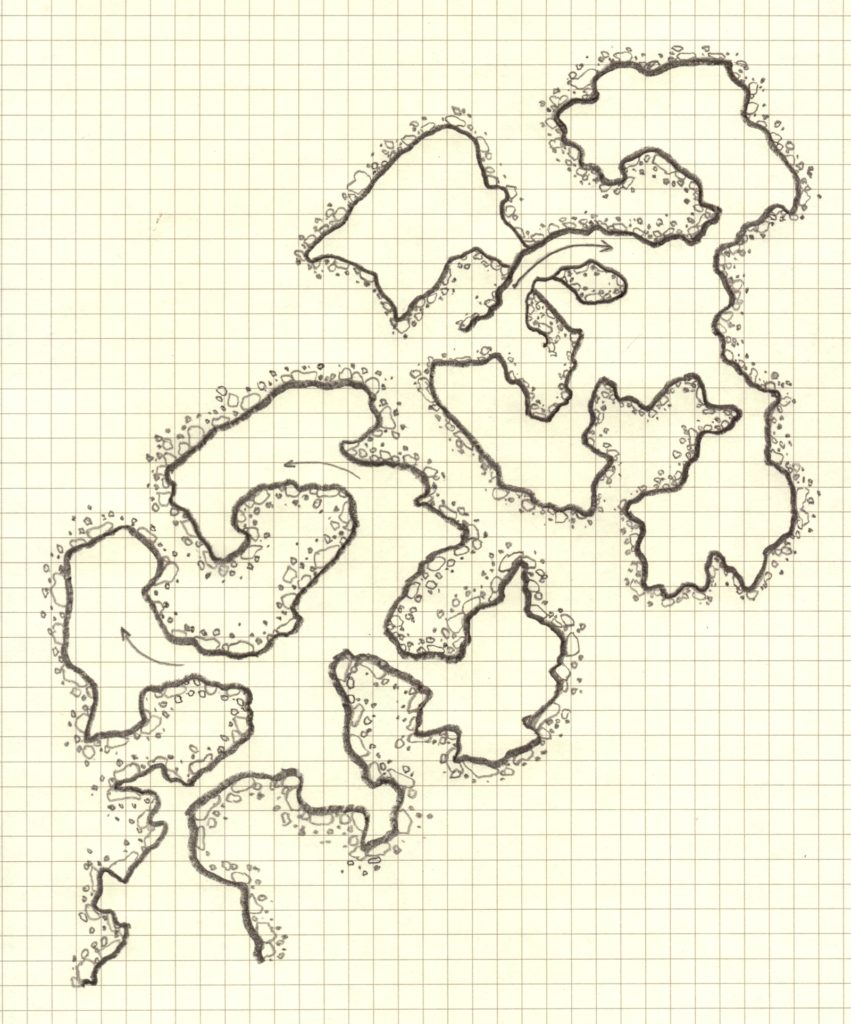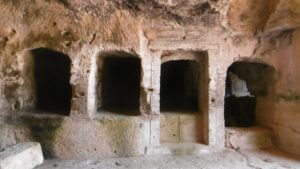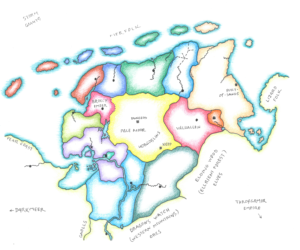Reading Map
This is the eighth article of a series outlining a B/X D&D campaign inspired by an old map.
- Atlantis of the Clay
- Warlock of the Pale Moor
- A Forsaken Peninsula
- Thirteen Graves
- Monstrous Denizens of the Pale Moor
- Base Town Emden
- Hekselannen
- Encounters in the Hex Lands
- Beyond the Pale
H. CREATE SPECIAL ENCOUNTER TABLES AND GENERAL LAIRS.
“There will probably be special areas of the wilderness map for which the standard encounter tables will not seem correct. The DM is encouraged to create his or her own tables for these places.”—D&D Expert Rulebook, Cook and Marsh, 1981, X54
Cook and Marsh give no guidance on how to create these tables. Should we make a simple dn table of monsters? Or should we create special tables using the Wilderness Encounters section (X57-8) as a guide—that is, an array of tables and subtables for each creature type: men, humanoid, flyer, etc., encountered in each biome: woods, river, swamp, etc.?
The latter is mighty complex, but I like the chance to encounter so many different monsters. If creating tables for large areas and the tables would get a lot of use, then I might go for that option. Before making tables from scratch, though, I would modify the existing tables, striking out undesired monsters and adding entries for those more common.
The former option is easier, although, on a simple table, each monster has an equal chance of appearing. I prefer a weighted table using two or more dice.1
We get such a weighted table in the AD&D Monster Manual II. Under the heading Creating Your Own Random Encounter Tables, we read:
“The following method of creating charts is based on the sum of 1 8-sided and 1 12-sided die, producing a range from 2-20 with a large flat spot of equal probability in the 9-13 range” (138).
Examining the odds of any given result of d12+d8, we see that the chance for each result in the “large flat spot of equal probability” is 8.33%. From there, the chance increases or decreases by 1.04% as the result goes up or down the table.
The MMII labels the flat spot as common and every two steps up and down as uncommon, rare, and very rare. Using this method, we have only to identify monsters based on the chance we’d like to encounter them.
Special Encounter Tables: Hekselannen
Roll normally on the major terrain types table (the first table of the Wilderness Encounters section, D&D Expert Rulebook, X57) to determine whether an encounter takes place. In city, inhabited, and water hexes, continue rolling on the section’s tables as normal. Re-roll any nonsensical result. (So many millennia from now, perhaps crocodiles will infest Europe’s north coast… or not.) When an encounter is indicated on the Pale Moor or its borderlands, roll on the appropriate column in the table below. See map in “Hekselannen.”
City: A hex containing a city (treat Emden as such) and within three hexes of it are considered city for purposes of determining wilderness encounters. Roll for an encounter once per week.
Inhabited: Hexes within the Thirteen Graves are patrolled, therefore, considered inhabited, except borderlands (see below). Roll for an encounter once per day.
Waterborne: Swimming or aboard a vessel on the sea or a river, roll on the ocean or river tables as normal. Roll for an encounter once per day.
Borderlands: Monsters make frequent forays into civilized lands from the Pale Moor. Borderlands are any hex within three miles of the perimeter.
Patrolled Areas and Wilderness Encounters
“The cleared area will remain free of monsters as long as it is patrolled. Patrols usually range up to 18 miles from a castle or stronghold, though jungles, swamps, and mountains will require a garrison every 6 miles to keep the area clear” (X52).
To reconcile the 1-in-6 chance for encounters in city and inhabited hexes with the above definition of a cleared area, that is, “free of monsters,” I count patrolled areas as inhabited. Much of the Thirteen Graves is swamp (fen and marsh) and clear with some woodland. Even without extra garrisons, most hexes outside the Pale Moor are within six miles of a town or stronghold. So, while “free of monsters” is optimistic, encounters are less frequent in patrolled areas.
Keep and Dungeon: In the south half of the Pale Moor, roll on the Keep table. In the north half, Dungeon.
In the table, a column for each area, before giving encounters, notes the chance for an encounter and, in parentheses, the number of times per day to roll the chance.
- Superscript letters E, N, S, and W designate halves of the region. For example, Borderlands entry 5, “OrcS/TrollN,” indicates an Orc encounter in the south, Troll in the north. The dividing line is left to the DM’s discretion.
- Where two monsters or types are given (divided by a slash “/”) without superscript designators, either choose or roll for it.
- Italic entries refer to subtables in the Expert Rulebook (X57-8).
- Bold entries refer to notes given below.
| Wilderness Encounters in Hekselannen | |||
| d12+d8 | Borderlands | Keep | Dungeon |
| Chance for Encounter (per day) | 5-6 (1) | 4-6 (2) | 4-6 (2) |
| 2 | Demon | Troll | Demon |
| 3 | Bugbear | Orc | Insect |
| 4 | Standard Encounter Tables | Standard Encounter Tables | Standard Encounter Tables |
| 5 | OrcS/TrollN | Demon | Bugbear |
| 6 | Merchant | Animal/Insect | Flyer |
| 7 | Troglodyte | Hill Giant | Troll |
| 8 | Hobgoblin | Bugbear | Hobgoblin |
| 9 | Patrol | Troglodyte | Troglodyte |
| 10 | Bandit | Goblin | Goblin |
| 11 | Adventurers/NPC Party | Kobold | Unusual |
| 12 | Animal | Hobgoblin | Humanoid |
| 13 | Brigand | Moor Wraith | Moor Wraith |
| 14 | Goblin/Kobold | Undead | Dragon |
| 15 | Flyer/Dragon | Adventurers | Adventurers |
| 16 | Moor Wraith | Flyer | Undead |
| 17 | GnollS/OgreN | NPC Party | Devil |
| 18 | Nomad | Dragon | NPC Party |
| 19 | Lizard ManE/Hill GiantW | Lizard ManE/LycanthropeW | Lizard ManE/LycanthropeW |
| 20 | Devil | Devil | Animal |
Animal: Replace crocodile and elephant with wolf, tiger with dire wolf, and giant piranha with giant sturgeon.
Humanoid: Replace cyclops with kobold.
Flyer: Re-roll pegasus.
Lycanthrope: d8, 1: werebear, 2: boar, 3-5: rat, or 6-8: werewolf.
Merchant and Nomad: These are Sadhakarani, a magical race of nomad traders. See “Monstrous Denizens of the Pale Moor.”
Unusual: Replace weretiger with werewolf.
Demon and Devil: DM’s choice from lesser demons and devils. Single entities are encountered unless campaign events dictate a horde is on the march.
Moor Wraith: To determine the base creature, roll again on the same table. Ignore demon, devil, and undead. A second moor wraith result indicates a double encounter with two wraith types.
Patrol: From nearest town or stronghold. Otherwise, treat as Castle Encounter (X59). Patrols may have different characteristics. A Valhallan patrol, for example, is made up of hobgoblins. A patrol displays a banner emblazoned with the grave’s heraldic device. Each grave may be further distinguished by a distinct color (for banner, tunic, pantaloons, and other accoutrements). Patrols do not go beyond the Pale.
False Patrol: There is a small chance, say 1-in-12 or 1-in-20, that a patrol is actually a band of brigands masquerading as a local patrol, outfitted in appropriate arms and armor and accoutrements of a local patrol. The brigands are on a scouting (70%) or raiding mission (30%). If raiding, the false patrol is accompanied by an equal number of brigands, undisguised and hidden until the attack.
Embellish Patrols
I take the idea for false patrols from the World of Greyhawk Glossography, compiled by Pluffet Smedger (Relmord: Royal University, CY 998). For more ideas to add flair to your borderland patrols, see that enigmatic volume (Encounter Tables, 4-5).
General Lairs: Troglodyte Caves
Appearing wherever sedimentary rock exposes itself between the spongy bogs and shallow meres on the Forsaken Peninsula, these caves were used for centuries by the reptilian humanoids who excavated them. Where possible, the troglodytes started with natural caves or fissures, expanding tunnels and caverns according to their needs. The caves tend to be shallow, with six- to eight-feet high ceilings. Mouths of troglodyte caves often open toward the south.
The troglodyte population now much reduced, many of these caves are inhabited by goblins, some by more fearsome creatures. Few remain empty for long, if not filled with brackish water, seeping in from the rising tides that ever menace the lowland peninsula.

Add scale and compass rose to suit.
Five-Room Dungeons
Five encounter areas is about right for a general sort of lair. To make these two, I referenced Mathew J. Neagley’s article on Gnome Stew, “The Nine Forms of the Five-Room Dungeon,” which I learned about recently from Dyson Logos. Lately, the map god is on a five-room dungeon binge: #5RD.
1 If you’re unfamiliar with the statistics of weighted tables, look at the odds of rolling a given number on a 2d6 table (as in Monster Reactions, B24, X23) or on a 3d6 table (as in Bonuses and Penalties Due to Abilities, B7, X2). Gygax gives a dice statistics primer in the AD&D Dungeon Masters Guide (9-10). See also Wandering DMs: Basic Dice Math | Season 1 Episode 22.

